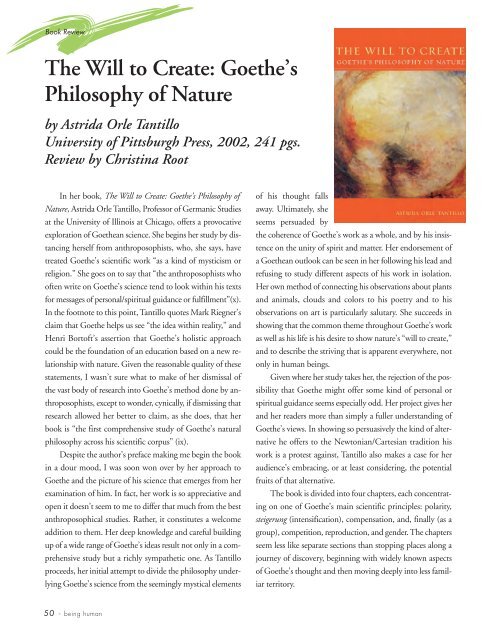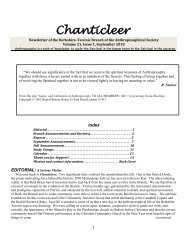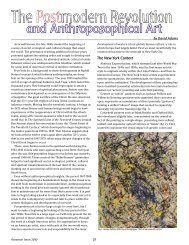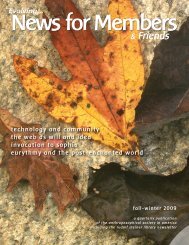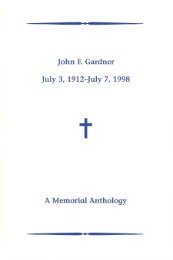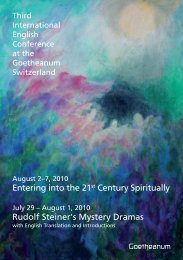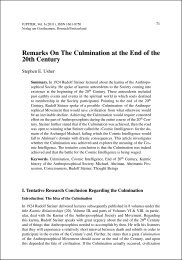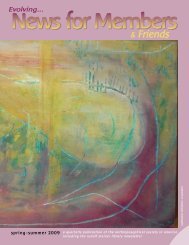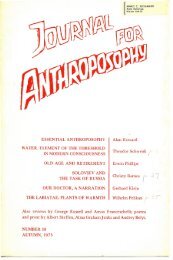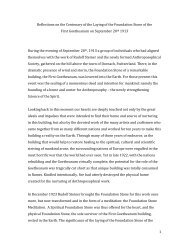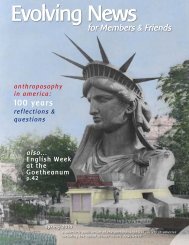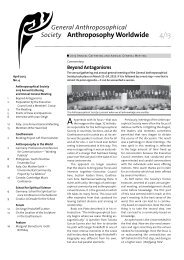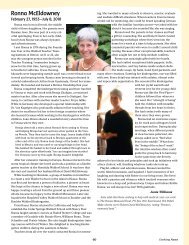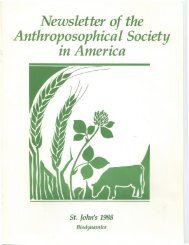Rudolf Steiner's Vision for the Future - Anthroposophical Society in ...
Rudolf Steiner's Vision for the Future - Anthroposophical Society in ...
Rudolf Steiner's Vision for the Future - Anthroposophical Society in ...
Create successful ePaper yourself
Turn your PDF publications into a flip-book with our unique Google optimized e-Paper software.
Book Review<br />
The Will to Create: Goe<strong>the</strong>’s<br />
Philosophy of Nature<br />
by Astrida Orle Tantillo<br />
University of Pittsburgh Press, 2002, 241 pgs.<br />
Review by Christ<strong>in</strong>a Root<br />
In her book, The Will to Create: Goe<strong>the</strong>’s Philosophy of<br />
Nature, Astrida Orle Tantillo, Professor of Germanic Studies<br />
at <strong>the</strong> University of Ill<strong>in</strong>ois at Chicago, offers a provocative<br />
exploration of Goe<strong>the</strong>an science. She beg<strong>in</strong>s her study by distanc<strong>in</strong>g<br />
herself from anthroposophists, who, she says, have<br />
treated Goe<strong>the</strong>’s scientific work “as a k<strong>in</strong>d of mysticism or<br />
religion.” She goes on to say that “<strong>the</strong> anthroposophists who<br />
often write on Goe<strong>the</strong>’s science tend to look with<strong>in</strong> his texts<br />
<strong>for</strong> messages of personal/spiritual guidance or fulfillment”(x).<br />
In <strong>the</strong> footnote to this po<strong>in</strong>t, Tantillo quotes Mark Riegner’s<br />
claim that Goe<strong>the</strong> helps us see “<strong>the</strong> idea with<strong>in</strong> reality,” and<br />
Henri Bortoft’s assertion that Goe<strong>the</strong>’s holistic approach<br />
could be <strong>the</strong> foundation of an education based on a new relationship<br />
with nature. Given <strong>the</strong> reasonable quality of <strong>the</strong>se<br />
statements, I wasn’t sure what to make of her dismissal of<br />
<strong>the</strong> vast body of research <strong>in</strong>to Goe<strong>the</strong>’s method done by anthroposophists,<br />
except to wonder, cynically, if dismiss<strong>in</strong>g that<br />
research allowed her better to claim, as she does, that her<br />
book is “<strong>the</strong> first comprehensive study of Goe<strong>the</strong>’s natural<br />
philosophy across his scientific corpus” (ix).<br />
Despite <strong>the</strong> author's preface mak<strong>in</strong>g me beg<strong>in</strong> <strong>the</strong> book<br />
<strong>in</strong> a dour mood, I was soon won over by her approach to<br />
Goe<strong>the</strong> and <strong>the</strong> picture of his science that emerges from her<br />
exam<strong>in</strong>ation of him. In fact, her work is so appreciative and<br />
open it doesn’t seem to me to differ that much from <strong>the</strong> best<br />
anthroposophical studies. Ra<strong>the</strong>r, it constitutes a welcome<br />
addition to <strong>the</strong>m. Her deep knowledge and careful build<strong>in</strong>g<br />
up of a wide range of Goe<strong>the</strong>’s ideas result not only <strong>in</strong> a comprehensive<br />
study but a richly sympa<strong>the</strong>tic one. As Tantillo<br />
proceeds, her <strong>in</strong>itial attempt to divide <strong>the</strong> philosophy underly<strong>in</strong>g<br />
Goe<strong>the</strong>’s science from <strong>the</strong> seem<strong>in</strong>gly mystical elements<br />
50 • be<strong>in</strong>g human<br />
of his thought falls<br />
away. Ultimately, she<br />
seems persuaded by<br />
<strong>the</strong> coherence of Goe<strong>the</strong>’s work as a whole, and by his <strong>in</strong>sistence<br />
on <strong>the</strong> unity of spirit and matter. Her endorsement of<br />
a Goe<strong>the</strong>an outlook can be seen <strong>in</strong> her follow<strong>in</strong>g his lead and<br />
refus<strong>in</strong>g to study different aspects of his work <strong>in</strong> isolation.<br />
Her own method of connect<strong>in</strong>g his observations about plants<br />
and animals, clouds and colors to his poetry and to his<br />
observations on art is particularly salutary. She succeeds <strong>in</strong><br />
show<strong>in</strong>g that <strong>the</strong> common <strong>the</strong>me throughout Goe<strong>the</strong>’s work<br />
as well as his life is his desire to show nature’s “will to create,”<br />
and to describe <strong>the</strong> striv<strong>in</strong>g that is apparent everywhere, not<br />
only <strong>in</strong> human be<strong>in</strong>gs.<br />
Given where her study takes her, <strong>the</strong> rejection of <strong>the</strong> possibility<br />
that Goe<strong>the</strong> might offer some k<strong>in</strong>d of personal or<br />
spiritual guidance seems especially odd. Her project gives her<br />
and her readers more than simply a fuller understand<strong>in</strong>g of<br />
Goe<strong>the</strong>’s views. In show<strong>in</strong>g so persuasively <strong>the</strong> k<strong>in</strong>d of alternative<br />
he offers to <strong>the</strong> Newtonian/Cartesian tradition his<br />
work is a protest aga<strong>in</strong>st, Tantillo also makes a case <strong>for</strong> her<br />
audience’s embrac<strong>in</strong>g, or at least consider<strong>in</strong>g, <strong>the</strong> potential<br />
fruits of that alternative.<br />
The book is divided <strong>in</strong>to four chapters, each concentrat<strong>in</strong>g<br />
on one of Goe<strong>the</strong>’s ma<strong>in</strong> scientific pr<strong>in</strong>ciples: polarity,<br />
steigerung (<strong>in</strong>tensification), compensation, and, f<strong>in</strong>ally (as a<br />
group), competition, reproduction, and gender. The chapters<br />
seem less like separate sections than stopp<strong>in</strong>g places along a<br />
journey of discovery, beg<strong>in</strong>n<strong>in</strong>g with widely known aspects<br />
of Goe<strong>the</strong>’s thought and <strong>the</strong>n mov<strong>in</strong>g deeply <strong>in</strong>to less familiar<br />
territory.


